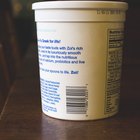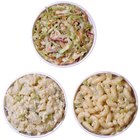tashka2000/iStock/GettyImages
Mayonnaise is an emulsification of eggs, oil and an acidic ingredient such as vinegar or lemon juice that generally lasts only a few days in the refrigerator when made fresh or several weeks when you purchase packaged mayonnaise. Freezer storage can keep mayonnaise from going bad. While the mayonnaise is safe to eat after freezing, it might separate and lose some texture.
Plain Mayonnaise
While you can freeze mayonnaise and it will hold its original form while frozen, the emulsion is likely to break as it thaws. The eggs, oil and vinegar or lemon juice separate, which results in liquid at the top of the mayonnaise. Packaged mayonnaise is usually stabilized to extend its shelf life, so separation won't be as severe. You can still use the mayonnaise, but you must either pour off the liquid or attempt to re-emulsify the ingredients. Do not expect the thawed mayonnaise to be the same as it was before freezing.
On Sandwiches
Mayonnaise on sandwiches does not freeze well, although it doesn't make the sandwich unsafe to eat. The liquids that separate make the bread soggy, which can ruin a perfectly good sandwich. The mayonnaise is already spread on the bread, so there's no way to even attempt emulsifying the separated ingredients. The best option is to freeze the sandwich without mayonnaise and add the mayonnaise after the bread and other ingredients thaw.
In Salads or Casseroles
Mayonnaise freezes best in salads and casseroles in which the mayonnaise is already distributed among other ingredients. While separation occurs just as with freezing plain mayonnaise and mayonnaise on sandwiches, you can stir the thawed salad or casserole to reincorporate the mayonnaise. The results won't be exactly the same as when made fresh, but the taste and texture will be close. Don't attempt to freeze lettuce-based salads because the lettuce and other vegetables wilt or become soggy. Freezing works best with foods such as tuna salad or chicken salad. When stored securely in freezer-bag packaging, they can stay safely frozen for up to two months.
Re-emulsifying Mayonnaise
When making fresh mayonnaise from scratch, there is no way to ensure you will achieve a perfect emulsion because the emulsion often breaks in the process. Given the difficulty of making fresh mayonnaise, attempting to re-emulsify thawed mayonnaise is more of a gamble than a sure bet, but it's worth a try. Add the thawed mayonnaise to a mixing bowl and whip it on high speed with an electric mixer to reincorporate the separated ingredients. If the ingredients don't emulsify well on their own, add water 1 tablespoon at a time to help bring them together. The resulting mayonnaise will be thinner than its original state.
Related Articles

Can You Freeze Casseroles With ...

How to Fix Mayo With Broken Emulsion

Can You Make Chicken Fettuccine Alfredo ...

How to Freeze Greek Yogurt

Can You Eat Expired Mayonnaise?
How to Use Yogurt or Sour Cream Instead ...

How to Replace Eggs With Mayonnaise

Is It Dangerous to Leave a Sandwich ...

Can You Eat an Egg That's Been Frozen?

Can You Freeze Cream Cheese & Whipped ...

How to Freeze Natural Yogurt

Freezing a Moussaka

How to Store Egg Whites
Can Lasagna Be Preassembled With Egg As ...

How to Freeze Tuna Salad

How to Store Cracked Eggs in ...

Miracle Whip & Mayonnaise Macaroni Salad

Does All Frozen Yogurt Contain Corn ...

How to Store Smoothies in the Fridge
Can Deviled Eggs Be Prepared Two Days ...
References
Writer Bio
A former cake decorator and competitive horticulturist, Amelia Allonsy is most at home in the kitchen or with her hands in the dirt. She received her Bachelor's degree from West Virginia University. Her work has been published in the San Francisco Chronicle and on other websites.